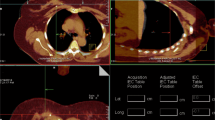Purpose:
In patients receiving salvage high-dose-rate (HDR) or pulsed-dose-rate (PDR) brachytherapy for a local recurrence on the chest wall or in the previously treated breast, clinical outcome and benefit were investigated. All patients had previously been treated with full-dose adjuvant external-beam irradiation (EBRT). Disease-free interval after salvage treatment, local tumor control and side effects were analyzed retrospectively.
Patients and Methods:
Between 1996 and 2002, a total of 32 consecutive patients were treated. 13 patients initially treated with mastectomy and postoperative irradiation and 19 patients initially treated with breast-conserving surgery and postoperative irradiation developed a local recurrence. The mean dose of previous radiation therapy was 58 Gy (range, 42–64 Gy), applied by conventional fractionation. After implantation ± surgery of recurrent disease and CT-based 3-D planning, 15 patients were irradiated with HDR-IMBT (intensity-modulated brachytherapy) with a mean dose of 28 Gy (range, 10–30 Gy, 2 × 2.5 Gy/day at 6-h daily interfraction interval) and 17 patients received PDR-IMBT with a mean dose 30 Gy (range, 10–45 Gy, 5 × 1 Gy/day at 2-h pulse intervals). Four patients underwent additional EBRT using a dose of 24–40 Gy electrons. Treatment was performed only on working days.
Results:
After a mean post-implant follow-up of 19 months (range, 1–83 months), no signs of local recurrence were observed in 20 of the 32 patients. In twelve patients, local recurrence occurred after a mean follow-up of 13 months (range, 1–78 months). 20 of the 32 patients experienced an additional systemic progress. In one patient, an EORTC/RTOG grade 3 side effect (ulceration of the skin) was described, which was followed by a local recurrence 12 months posttherapeutically.
Conclusion:
Perioperative interstitial HDR/PDR-IMBT of localized breast or thoracic wall recurrences following previous full-dose EBRT appears to be a meaningful salvage treatment with acceptable toxicity.
Ziel:
Die klinischen Ergebnisse und der Nutzen für vorbestrahlte Patientinnen, die aufgrund eines Thoraxwand- oder Lokalrezidivs nach brusterhaltender Therapie eine interstitielle High-Dose-Rate-(HDR-) oder Pulsed-Dose-Rate-(PDR-)Brachytherapie erhielten, wurden untersucht. In einer retrospektiven Beobachtungsstudie wurden das krankheitsfreie Überleben, die lokale Tumorkontrolle und die Toxizität analysiert.
Patienten und Methodik:
Zwischen 1996 und 2002 wurden 32 vorbestrahlte Patientinnen mit einem Lokalrezidiv behandelt. 13 Patientinnen waren initial mastektomiert und 19 Patientinnen brusterhaltend operiert worden. Alle Patientinnen waren im Bereich der Thoraxwand oder der Brust vorbestrahlt (mittlere Dosis 58 Gy, Spannweite 42–64 Gy). Nach CT-gestützter 3-D-Bestrahlungsplanung wurden 15 Patientinnen mit HDR-IMBT (intensitätsmodulierte Brachytherapie) mit einer mittleren Dosis von 28 Gy (10–30 Gy, 2 × 2,5 Gy/Tag, Intervall von 6 h) bestrahlt, und 17 Patientinnen erhielten eine PDR-IMBT mit einer mittleren Dosis von 30 Gy (10–45 Gy, 5 × 1 Gy/Tag, Pulsintervall 2 h). Vier der 32 Patientinnen erhielten zusätzlich eine perkutane Bestrahlung bis zu einer Dosis von 24–40 Gy mit Elektronen. An Wochenenden und Feiertagen erfolgten keine Bestrahlungen.
Ergebnisse:
Nach einem mittleren Intervall von 19 Monaten (1–83 Monaten) fand sich bei 20 der 32 Patientinnen kein Hinweis auf ein lokales Rezidiv. Zwölf Patientinnen entwickelten im Durchschnitt nach 13 Monaten (1–78 Monate) Lokalrezidive. Bei 20 der 32 Patientinnen kam es im Verlauf zu einem systemischen Progress. Bei einer Patientin trat 1 Jahr nach Therapie eine Grad-3-Nebenwirkung (Ulzeration der Haut) auf, gefolgt von einem lokalen Rezidiv.
Schlussfolgerung:
Die perioperative interstitielle HDR/PDR-IMBT der Thoraxwand oder der Brust bei der Behandlung von Lokalrezidiven nach vorheriger kompletter perkutaner Strahlentherapie scheint eine vertretbare Therapieoption mit einer akzeptablen Toxizitätsrate zu sein.
Similar content being viewed by others
Author information
Authors and Affiliations
Corresponding author
Rights and permissions
About this article
Cite this article
Niehoff, P., Dietrich, J., Ostertag, H. et al. High-Dose-Rate (HDR) or Pulsed-Dose-Rate (PDR) Perioperative Interstitial Intensity-Modulated Brachytherapy (IMBT) for Local Recurrences of Previously Irradiated Breast or Thoracic Wall Following Breast Cancer. Strahlenther Onkol 182, 102–107 (2006). https://doi.org/10.1007/s00066-006-1496-x
Received:
Revised:
Issue Date:
DOI: https://doi.org/10.1007/s00066-006-1496-x
Key Words:
- Breast cancer
- Local recurrence
- Perioperative brachytherapy
- High-dose-rate brachytherapy
- Pulsed-dose-rate brachytherapy
- Intensity modulation




